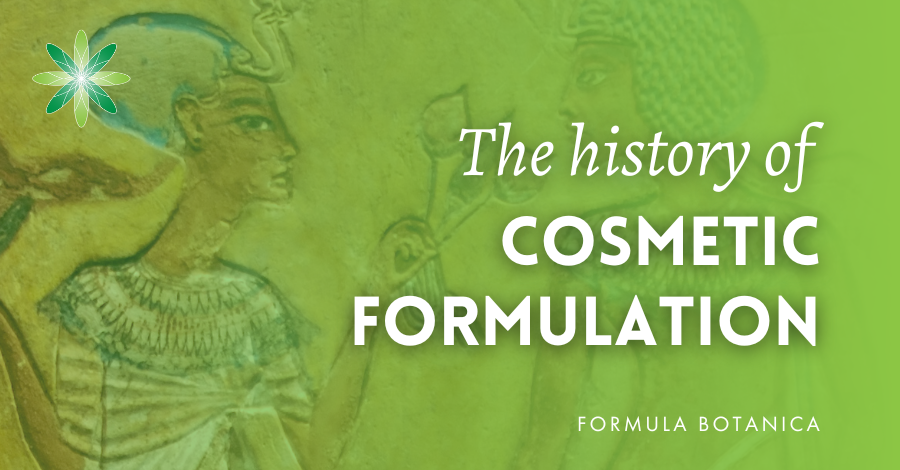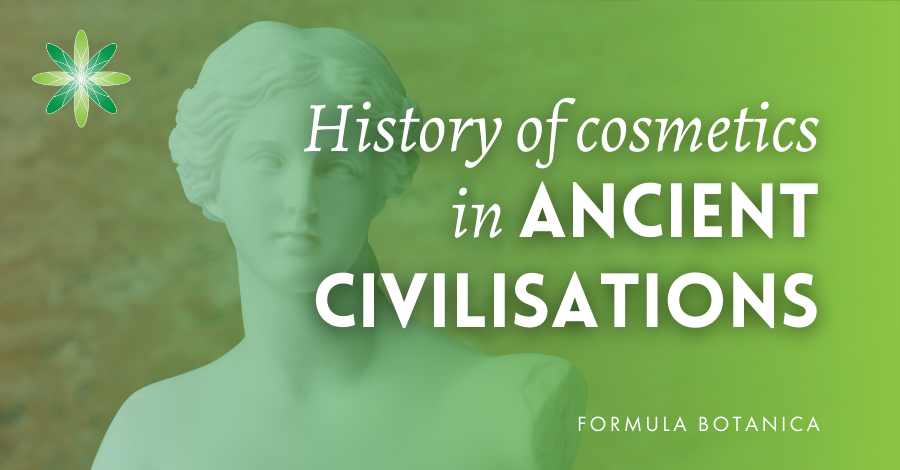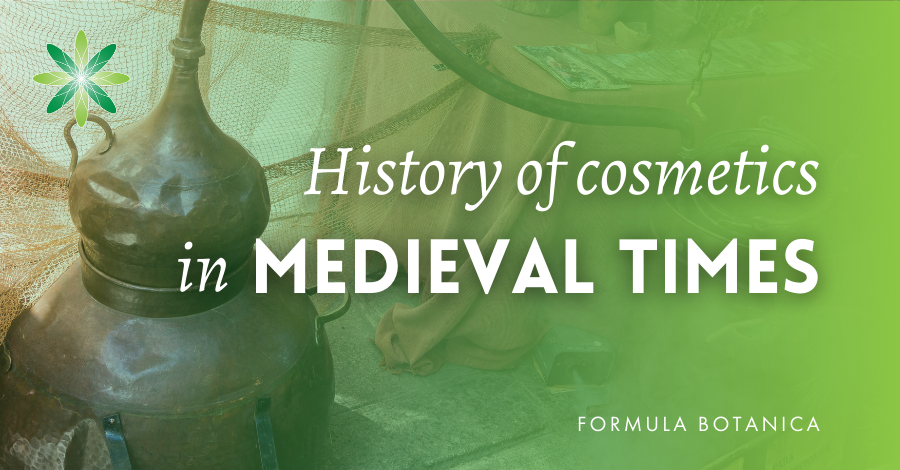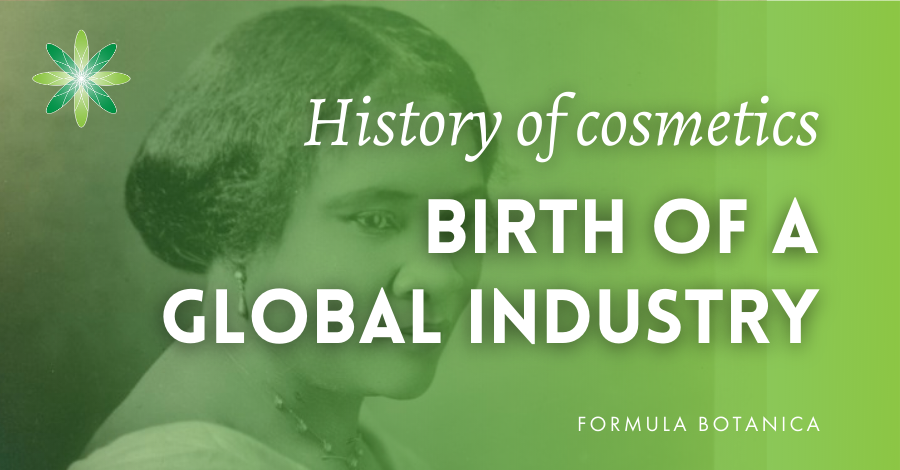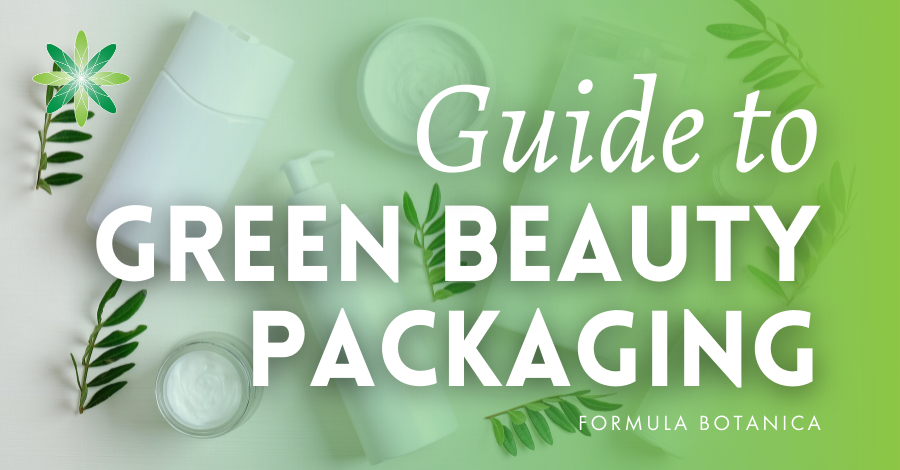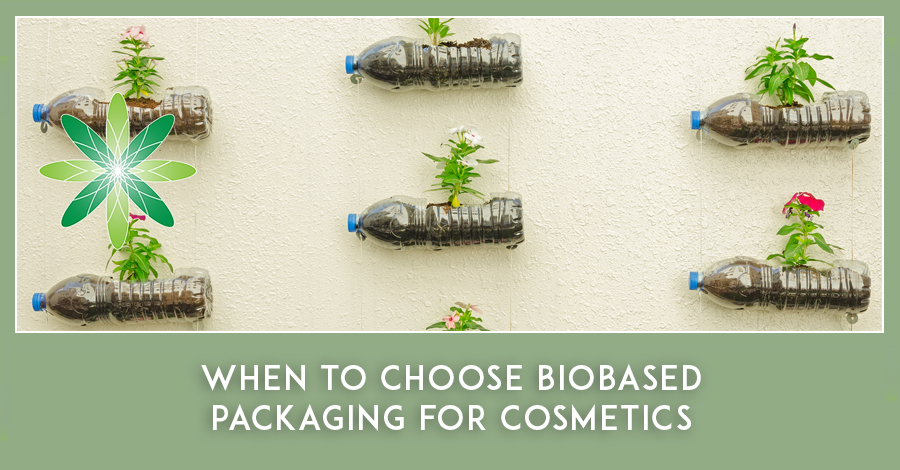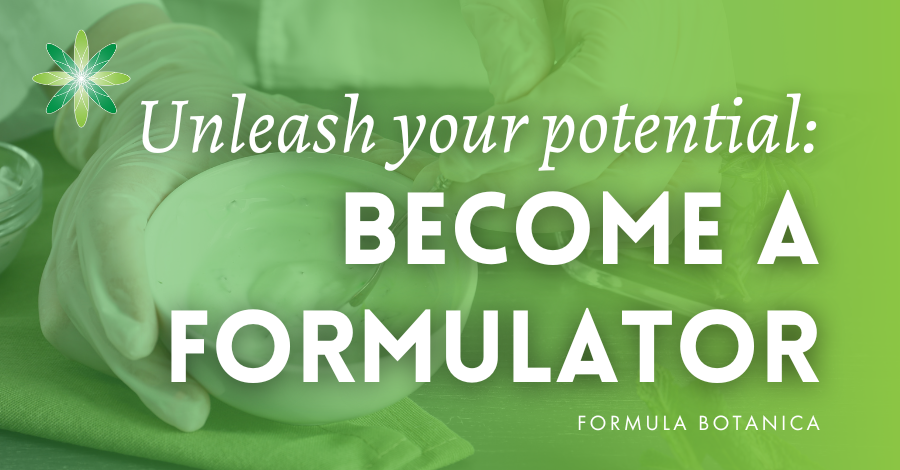The history of cosmetics is more than about the giant beauty brands of the 20th century. Yet, it is hard to believe that the global cosmetics industry, which was valued at just under a staggering USD 308 billion in 2020(i), barely existed until a little over a 100 years ago.
In centuries past, before the emergence of today’s personal care giants such as L’Oréal, Unilever, Proctor & Gamble, Elizabeth Arden, Helena Rubenstein, Estée Lauder, Johnson & Johnson, Coty, and Shiseido, cosmetics were made on a very small scale, usually within the home, village or local community. These formulations would have been handed down, but not always written down, from generation to generation, and formed part of a community’s vernacular.
Since Ancient Egyptian times and in similar ancient civilisations in China, in the Indus River Valley and also among indigenous peoples the world over, cosmetic preparations were made for a variety of reasons, such as to adorn, to purify and cleanse the body, to ease skin conditions, for use in religion, to attract the opposite sex, or to ward off enemies in battle. In short, cosmetics were for both personal expression and part of shared cultural traditions and norms, which in many senses is just why we use them today.
Indie beauty is shaping the history of cosmetics
As natural formulators in the indie beauty community, we are part of this continuum of the history of cosmetics and in a unique way too. The indie beauty movement is looking for sources of inspiration and ingredients in the selfsame plants that humankind has used since ancient times, and in doing so it is shaping a new chapter in cosmetics’ history – the beauty industry beyond global beauty conglomerates.
It is taking cosmetics’ manufacture full circle by returning formulation to its more sustainable roots. Importantly, indie beauty is showing that successful cosmetics’ brands can be built by anyone, almost anywhere and without the need for sophisticated laboratories.
Comparing the manufacture of cosmetics throughout history with the indie beauty sector of today is an interesting journey to take. In this article, we take a brief look at some of the key, defining moments in the history of botanical cosmetics to see why and how natural formulators of today have much to be proud of in carrying the best of the past into their futures as cosmetics’ entrepreneurs in the 21st century.
A brief history of natural cosmetics
Ancient civilisations and the dawn of cosmetic preparations
The oldest known written formulation was discovered on a 5,000-year old Egyptian scroll – the Edwin Smith papyrus – and entitled “Transforming an old man into a youth”. A US dermatologist, Stanley Jacobs, with a keen interest in Egyptology, had the formulation analysed and found it to contain mandelic acid obtained from bitter almonds. Today, we use mandelic acid as a natural alpha-hydroxy acid (AHA) liquid exfoliant to encouraging cell renewal to improve in particular the appearance of mature skin by “peeling back the years”. Jacobs later patented the knowledge gleaned from the papyrus and now runs a successful skincare line based on this discovery (ii).
The Sumerians, Assyrians, Babylonians and Egyptians were experts at using a range of plants we commonly use in natural formulation today in their unguents, oils, ointments, poultices, powders and more. To give just one example, an ancient Egyptian body oil formula comprised sesame, castor, moringa and olive oils (iii). All these oils are commonly used now with some, like moringa, ironically, seen as a trending newcomer ingredient in natural formulation today.
Many ancient civilisations believed plant essences possessed spiritual, supernatural powers. This is easy to understand since some plants have mind-altering properties. Today, these ancient “plants of the gods” are keenly studied by ethnobotanists and neuroscientists. Consider, for example, the ongoing debate and varying regulations across the world on the cosmetic use of CBD – cannabinoids.
Moving on to later periods, there is plenty of evidence of cosmetic preparations from the annals of history that are quite familiar to us now. Archaeologists discovered a well-preserved Roman face cream dating back to 150 A.D. when excavating a site in London – it still had preserved fingerprints in it. A scientific paper in the journal Nature analysed the cream and found that it contained animal fats, starch and the mineral, tin oxide. When they replicated the cream, they found it felt pleasant on the skin and were surprised to find that modern-day cosmetics still use starch for the same purpose. Similarly, many modern cosmetics use tallow or plant fats.
Cosmetics from the Middle Ages to modern day
The collapse of ancient civilisations followed by internecine battles among tribes in Europe and the Middle East took their toll on sites like the library of Alexandria, Egypt, and other document archives in places like Athens (iv). Most of what we know of medieval cosmetics and botany was rescued, researched and documented by the Arabs. Their knowledge then passed throughout Europe from around 800 A.D. to Renaissance times.
Spain, thanks to its Arab population in the early Middle Ages was a great seat of learning and of scientific advances and it is probably from there that the process of alembic distillation gradually spread throughout Europe. The oldest distillation apparatus discovered was in modern-day Iraq; the Mesopotamia of ancient times (iv). Monasteries in countries like Italy and France translated Arabic texts and so onward went the knowledge of plants and their herbal medicinal and cosmetic properties. Although the Middle Ages are often considered dark ages, many achievements of phytotherapy were recorded in medieval times and still stand up to the rigours of scientific research today (vi).
In other parts of the world, ancient knowledge was also transcribed and preserved, whether orally or in texts. Archaeological finds in China and study of ancient Indian herbal cosmetics demonstrate the wealth of knowledge of plant extracts in addressing skin conditions. Some of these ancient formulae are still in use by some rural women in the interior of India while others form part of the Ayurveda branch of medicine (vii).
But, our focus for now is on how Europe and later the US became the precursors of today’s global cosmetics industry.
The Renaissance, or rebirth of learning, the arts and exploration, and in particular the 16th century, saw cosmetic preparations being used for pleasure not just to “cure” skin ills. The opening up of trade with the New World, the Americas, as well as Silk Road trade from the East to Venice, brought more exotic ingredients to Europe to include in cosmetics. We begin to find in this period formulations that have many similarities with modern gels, scrubs, oils, toners and washes.
However, many bizarre and often deadly ingredients were included such as arsenic and lead which were in use in cosmetics from the mid 1500s to at least the late 1700s as women yearned for the pale skin these ingredients induced.
The birth of modern cosmetics and a global industry
Moving to the modern-day beauty industry that arose in the late 1800s, we find that many of the great beauty pioneers of the era were also indie formulators. Many of their names live on today in the global cosmetics brands we mentioned at the start. We dedicated an article to some of the women beauty industry pioneers of this era who can rightly claim to have created the modern cosmetics industry. Most of them, however, began life as lone entrepreneurs – rather like many indie brand founders today.
Elizabeth Arden worked as a bookkeeper at a pharmaceutical company and started working in their lab in her spare time because she found skincare so interesting. Estée Lauder formulated her first cosmetics on a gas burner in a converted New York restaurant after she was inspired by her uncle setting up a makeshift skincare lab in her family’s stables.
Madam C. J. Walker, who is another fabulous example of a home formulator turned successful brand owner, had her story turned into the film “Self Made” on Netflix. Helena Rubenstein was the first beauty pioneer to start wearing white lab coats in her adverts; a genius marketing technique. She had no scientific qualifications herself beyond a two-month tour of European skincare facilities.
Turning to some men, we find Eugene Schueller, the founder of L’Oréal, a pharmacist by training but who spent years in his own kitchen in Paris causing frequent explosions until he finally invented the world’s first hair dye. While David McConnell, the founder of Avon, was a book salesman who realised his customers were more interested in beauty products, so he mixed the company’s first fragrances himself in a small office.
The global cosmetics industry of today ramped up after the Second World War in the United States. Advances in chemistry during the war years saw new types of ingredients that were found of great use in cosmetics; for example, a military camouflage paint gave rise to a sunscreen which in turn inspired a face cream.
The advent of the silver screen and the film diva created the ideal of the “American Beauty” (viii). The cosmetics industry grasped this concept as a marketing opportunity and ran with it to produce cosmetics en masse for the masses who desired those film-star looks for themselves. From here onwards, the global cosmetics industry was born and never looked back. In its runaway growth, the US/Western beauty ideal dominated cultures across the world creating immense demand for the US-produced cosmetics from the big brand personal care companies. The rest, as they say, is history.
How indie formulation today connects us to the past
Formulation, while it takes time to learn, is fun and empowering, and people have been doing it for millennia as our short history of cosmetics shows. It connects us to ancient wisdom of plants which is increasingly being born out by current scientific research.
Many Formula Botanica students tell us how grounding they find it to be working with plants that have been known to, and used by, man for millennia. We have graduate brands infused with the traditional use of plants such as those founded on principles of, for example, Ayurveda, or on ingredients African women have used for centuries to protect and nourish their skin.
There have of course been many dubious ingredients used in cosmetics over the centuries, but the fundamental principles of formulation still stand: emulsification, solubilisation, gelling, warm blending, whipping, distillation, enfleurage, preservation and so on are all age-old techniques used today by cosmetic chemists and home formulators alike (as well as chefs).
Thankfully, we now have a growing understanding of which ingredients we should and shouldn’t use, although we have a way to go with the scientific research to back up traditional knowledge. It is incredible to think that the Ancient Egyptians knew of the potential of an extract of bitter almonds to rejuvenate skin.
Yet, for all our scientific awareness, we still see cosmetic ingredients, beauty packaging and manufacturing processes in use in the cosmetics industry that are unsustainable and contributing to environmental degradation. Without better stewardship of our planet, it remains to be seen how many decades let alone centuries, we will have the bounty of botanicals to work with that our ancestors did.
What cosmetics history tells us about formulation today
History shows us, from ancient times to the modern cosmetics industry started by those early pioneers, that you do not need a qualification in chemistry to formulate natural cosmetics. Chemists and non-chemists alike can be great formulators; similarly, both can also be terrible formulators.
The indie beauty community has further demonstrated that formulation is a skill accessible to everyone, as tens of thousands of small brands that have appeared almost from nowhere in the last decade have shown. The innumerable beauty industry awards Formula Botanica graduates have won are testimony to the success and innovation these indie brands are capable of.
As a result of the growing movement in natural formulation, Formula Botanica has taught over 16,000 students and graduates in 180-plus countries. among them we count home formulators, DIYers, indie beauty brand owners, cosmetic chemists, pharmacists, manufacturers, formulation consultants, chemistry lecturers, lab technicians, aestheticians, hairdressers, salon owners and more. We have taught scientists and non-scientists from pretty much every walk of life.
We’ve also taught over 300,000 people for free through our online Masterclasses. We now have a Continuing Professional Development membership site – The Lab at Formula Botanica – which regularly features some of the big ingredient suppliers, who recognise that the indie formulators of today are the big brand founders of tomorrow and want to join us.
There is no standard education route to making your own cosmetic products, any more than there was throughout the millennia we skimmed through above. But the beauty industry has told us since the early 20th century that only scientists should do so. This of course makes no sense coming from mainstream brands which came into being by the sheer determination of individuals, the majority of whom had no chemistry nor formal science experience or training.
Be part of the continuum of natural cosmetic formulation; be part of shaping this new era in the history of cosmetics that rekindles our connection to the past, empowers us to all be formulators and to be the lynchpin between botanical ingredients and cosmetics’ users whether family, friends or customers.
You too could be part of a student body across the world that is learning to formulate and join our gallery of successful graduate brands. Start now by signing up for our free training: How to become an organic skincare entrepreneur.
Further reading and references
(i) Global Cosmetics Market Report, 2022. Globe Newswire
(ii) Defy Age Using a 3,600-Year-Old Face Cream Recipe With a Deadly Ingredient: Atlas Obscura, 16.12.16.
(v) Schlosser, Stefan. (2011). Distillation – from Bronze Age till today.
Photo Credit: Wiki Commons – Madam C.J. Walker
FREE TRAINING
Learn how to become an
Organic Skincare Formulator
FREE TRAINING
How to become an
Organic Skincare Entrepreneur
FREE TRAINING
How to become an
Organic Skincare Entrepreneur
Leave us a comment

Liz was Formula Botanica’s Content Coordinator between August 2020-2024. Liz worked as a professional blogger, journalist and site developer for many years and was also part of the Formula Botanica student community. Read more about the Formula Botanica Team.

